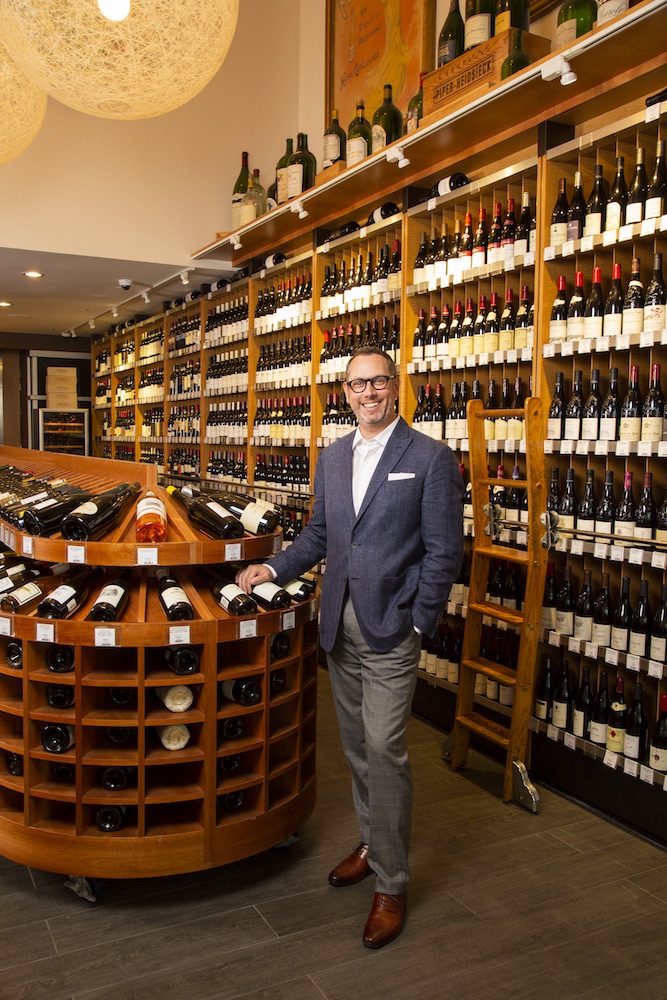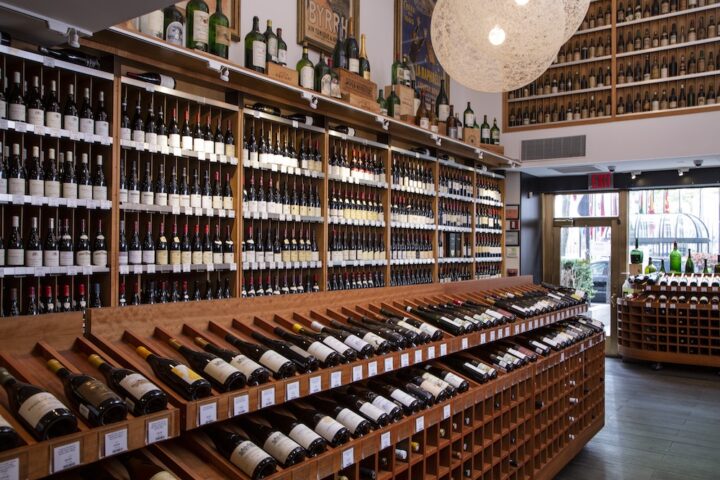
Among the towering skyscrapers that make up New York City’s Rockefeller Center sits Morrell & Co., a 73-year-old fine wine and spirits retailer. In the decades since its founding, Morrell has expanded well beyond its original retail identity, adding an on-site wine bar to the mix, as well as an auction program and storage space in the New York City borough of Queens. While the retailer has kept up with the changing times, implementing new technologies and incorporating unique services where necessary, its core identity has remained firmly in place; if anything, it’s grown sharper over time, and especially in recent years, thanks to the direction of CEO Jeremy Noye.
Noye took the reins at Morrell in 2014, succeeding second-generation owner and CEO Peter Morrell. Since coming to the company’s helm, Noye has implemented not a sweeping modernization of Morrell, but instead homed in on what first made the fine wine powerhouse an international name: its adherence to offering high-end, collectible, and classic labels. For his dedication to keeping Morrell close to its roots, all while moving the company forward into modern times, Jeremy Noye has been named a 2020 Market Watch Leader.

Fine Wine Roots
Before Noye realized a love for fine wine, he aspired to life in a kitchen—that goal a byproduct of growing up in a family that operated a number of local restaurants throughout central Pennsylvania. He eventually landed at the Culinary Institute of America in 1995; soon after starting his studies, however, he realized that being a chef wasn’t for him. “While I still love to cook, I learned through culinary school that I don’t like cooking the same dish over and over, everyday,” says Noye. “But what I did find was that I love interacting with people, and helping them put together a complete experience—from serving, to pairing wine with food, to complex tableside service.” This realization led Noye to pursue various front-of-house restaurant positions in New York City after graduation from the Culinary Institute. He went first to Café Pierre in 1998, serving as assistant manager, and had management and beverage director stints at various other New York City-based restaurants and bars.
In 2007, Noye made the jump from serving wine to selling it, joining the team at Scarsdale, New York-based retailer Zachys as a wine buyer. He spent seven years at Zachy’s before moving on to Crush Wine & Spirits in Midtown Manhattan as vice president in 2013; just a year later, however, an opening at Morrell drew him away, and Noye has never looked back.

Retail Refocus
Noye’s first mission as the newly minted president and CEO of Morrell was to bring the company back to its tried-and-true retail roots. As it had grown to encompass new entities—an auction program in 1994, storage under the Vintage Wine Warehouse moniker in 1995, and a wine bar in 1999—its original focus had wavered slightly, in line with a larger trend in wine retail to have a hand in every pocket of the wine world. “When I came on in 2014, we made a strategic decision that we couldn’t be the historical brick-and-mortar wine shop that Morrell was in the same model that many of our peers are in today or were in then, which is: You try to be something for everyone,” says Noye. “We quickly determined that we could not be, and did not want to be, the wine shop for everyone. So we made a conscious decision to focus on the more collectible, historic, and proven properties and regions that are the foundation upon which Morrell was built.”
To that end, Morrell’s retail side has condensed its selection in the six years since Noye’s arrival, primarily highlighting such famed French regions as Bordeaux and Burgundy, as well as high-end labels from established Old World players like Italy, Spain, and Germany. Cult classics from California also play an important role for the retailer and serve as its primary New World focus. Noye acknowledges that while this limited approach has meant actively passing over a wide swath of smaller, up-and-coming wine regions, it’s in turn cemented Morrell’s status as a collector’s haven, and in doing so drawn devoted customers from across the globe. “We’re not working on emerging regions, or regions that are trendy in restaurants,” he says. “We’re focusing on our core business—which is higher-end wines—and catering to collectors.” Today, Morrell has upwards of 3,000 active selections on any given day, with that number reaching as high as 6,000 at times; in all, the wine inventory is worth some $10 million.
Most of the retailer’s business is in French wine, comprised first and foremost of Bordeaux labels. Bordeaux futures, which have long been an important part of business, have seen an uptick in growth at Morrell in recent years, with brands like Domaine de Chevalier doing particularly well at the $55-$60 price point. Noye notes that wines from Champagne, the Rhône, and Jura, among other French regions, also do well, though from smaller volume bases. Italian greats like Barolo and Barbera are popular at Morrell, attracting the collector set, as are legacy labels from Germany and Spain. From the U.S., Opus One and Far Niente command regular business, joining famed labels like Screaming Eagle.
Spirits play a lesser role at Morrell, but, as with their wine counterparts, they skew upscale and collectible. “Most of our spirits are brown spirits, and they tend to be harder to come by,” says Noye, pointing to whiskies like the Pappy Van Winkle Family Reserve 23-year-old Kentucky Straight Bourbon ($3,500 a 750-ml.) as exemplary of that approach. While Bourbon and Scotch each have a solid presence carved out at the store, Japanese whisky is far and away the single most important spirit offering at Morrell, with Noye noting that the store has one of the largest—if not the single largest—collection of rare Japanese whisky in U.S. retail. Overall, Morrell stocks around 300-500 spirits SKUs on any given day, with the majority relegated to whiskies and collectible Cognacs.
Aside from Morrell’s substantial selection, essential to its business are its employees. “People look at Morrell and its history and they assume our online business is a crucial piece of the pie,” says Noye. “And that business is important, but quite frankly, our largest volume of sales still comes from our wine consultants and our one-on-one interactions with consumers; that’s what we do best, and it’s two-thirds of our volume.” Morrell employs ten salespeople, who handle their own respective portfolios of clientele.

Building Out Business
Aside from its formidable retail front, which has stayed strong through many an economic downturn—including the current one brought on by Covid-19—Morrell has financed a full-service experience for its consumers by adding a wine bar, storage space, and auction program under its umbrella. “To this day, Morrell is the only wine company in New York—to my knowledge—that has a full-service approach for a consumer’s wine needs,” says Noye. “We’re the only one with a retail store, a wine bar, and auction and storage components. Many other retailers may have a combination, and we’ve seen more of the wine retail and bar elements come together in recent years, but Morrell was the first of its kind to do so.”
Morrell expanded into the on-premise in 1999 with the Morrell Wine Bar, which, until 2014, gave people a chance to try almost any wine offered at the retail store. Once Noye came on, however, the bar’s strategy shifted in favor of carving out its own identity separate from that of the retail component. “The wine bar became the place to showcase the first foray into a winery or producer’s wines,” says Noye. “The more collectible, age-worthy wines stay on the retail side, whereas you’d see a village-level Burgundy or the second wines of a Bordeaux château by the glass at the wine bar. It’s created a nice harmony between the two components.”
On any given day, Morrell Wine Bar offers around 75-100 by-the-glass wines. Even as a winery’s more entry-level offerings play an important role at the wine bar, such high-end, hard-to-find wines as Opus One, classified-growth Bordeaux, and grand cru Burgundy are also offered on a limited basis. “The other piece that we began incorporating was to let the wine bar introduce more of the regions and categories that the retail store wasn’t working with as much, and see where the clientele’s interests were so that we could stay fresh and up to date with what’s going on in the wine world from a holistic standpoint,” says Noye. He points to wines from regions like the Canary Islands as popular new picks. Morrell’s business operation also includes auction and storage elements, both of which are in the midst of major new developments. Noye paused Morrell’s auction program when he joined the team in 2014, shifting focus almost entirely to reshaping the company’s retail mission. Now, he’s intent on restarting the program. Moving forward, all of Morrell’s auctions will be held online for greater accessibility. The auctions will also be smaller and will be held more frequently—around once a month, and potentially more often over time. “The lot sizes will be on average purposely smaller, therefore giving the retail buyer more opportunity and access,” says Noye. “We’re trying to lessen the intimidation factor of auctions, and create more ease of purchase.”
Morrell has also offered its clients storage space since 1995, and the company now owns one of the largest storage facilities in the tri-state area, according to Noye. The space has seen a steady uptick in growth in recent years; this momentum comes alongside a shift in the consumers who are searching for storage. “There’s more people looking for storage who come to us with a smaller amount of wine, rather than just a handful of people with enormous amounts of wine,” Noye observes. “And that’s more or less a generational age shift in the collecting mentality.”
This fall, Morrell is set to open a second storage facility in Delaware, which Noye says will be built for more long-term storage, as opposed to smaller, in-and-out accounts.

Contending With Covid-19
The onslaught of Covid-19 has impacted the global community, and while some wine and spirits retailers certainly saw business boom during the pandemic’s early days, Noye says that Morrell’s sales have risen only moderately, and that the average bottle sale price actually has fallen slightly, from an average of $150 a bottle down to $125. That said, the retailer has had plenty of bright spots. “We’ve seen popularity with moderately back vintage wines,” says Noye. “And we’ve been selling an intense amount of Champagne since the onset of Covid, so we’ve since put forward more offerings on that front.” While Morrell’s auction and storage entities are forging ahead amid Covid-19, the wine bar shuttered in late March and had yet to reopen by press time.
“We’re an older company, but we’ve slowly been changing and modernizing,” says Noye. “With those changes, though, we’re using this foundation of going back to basics, to rebuild and reposition and focus on a specific clientele. Ultimately, we’re trying to provide unparalleled access to luxury, limited wines for our consumers, and give them that comfort and reliability that we’ll always have that selection.”